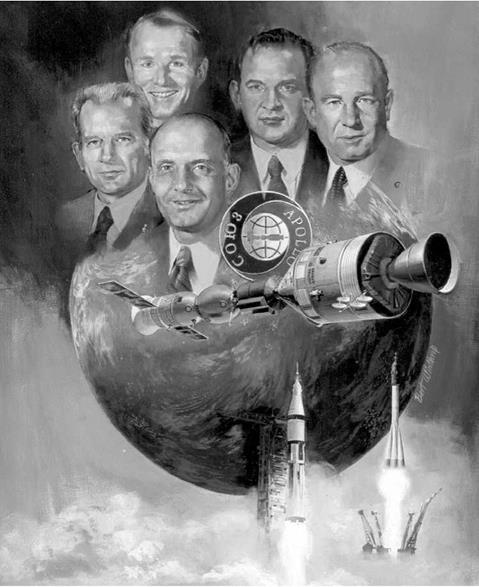International manned space flight
In 1972, after several years of negotiations, the first joint mission between the Soviet Union and the USA was agreed, and was launched in 1975 as the Apollo-Soyuz Test Project, or ASTP. In order for the Apollo and Soyuz crews to join together in orbit, a docking module was developed to allow a physical link between the two spacecraft.
|
Artwork depicting the highlights of the historic ASTP international space mission. Dual launches, a docking in space and the five crew members. l to r Slayton, Brand, Stafford, Kubasov, Leonov with the programme logo in the centre |
The docking module was an airlock 3 m (10 ft) long and over 1 m (3 ft) in diameter. It had an Apollo LM-type (drogue) docking port at one end to take the Apollo docking probe, and at the other end was the androgynous docking system. This consisted of an extendable guide ring with three petal-like plates on its circumference, each plate
|
Table 3.5. ISS major elements dimensions as of 2006
|
having a capture latch inside it. Once the latches of both craft were engaged, the active vehicle retracted the guide ring, pulling the craft together. The docking module was jettisoned by the Apollo crew prior to retro-fire.
The Soviet Union also flew a series of Interkosmos missions with cosmonauts from several Soviet bloc countries, starting in 1978. This led to a series of international commercial missions and cooperative missions with European and US astronauts, and the creation of the opportunity to sell seats to rather affluent “tourists”.
NASA’s Space Shuttle Spacelab programme has featured several international missions using a series of modules in the payload bay and these have particularly assisted the crews to gain the experience needed for the International Space Station. Spacelab 1 consisted of a 15,088 kg long module, single pallet and aim (3.3 ft) diameter, 5.8 m (19 ft) long tunnel from the modular Spacelab hardware kit. Over the years, there would be sixteen module flights of Spacelab, six pallet-only missions and a further eleven Shuttle missions featuring Spacelab pallets that supported a variety of payloads, many of them international in nature.
The International Space Station programme evolved from a 1984 US presidential initiative to create a large space station. A cooperative team of 16 nations worked to launch separate elements of the station and construct it in orbit over several years, resupplied by American Shuttle and Russian Soyuz and Progress vehicles. The Zarya module was a descendant of the add-on Mir modules, whilst Zvezda was similar to the Mir base block.
Shenzhou
This Chinese manned programme aims to establish a manned “space station’’ in orbit within a few years. Two Shenzhou orbital modules will be linked together to establish a precursor space laboratory, before a more permanent station is launched.
After years of speculation and four unmanned test flights, China achieved what it had planned for decades – the capability to put Chinese citizens in space independently.
Forty years after the Soviet Union and America started the human space flight programme, China became only the third nation to claim manned space flight capability. Such capability was envisaged in the mid-1960s, and in the 1970s, a programme called Dawn (Shuguang) was planned. Even though astronaut trainees were selected in April 1971 (Project 714), the project progressed very little and was terminated in 1972. It remained a guarded secret for over thirty years. A serious space biomedical programme continued in China, as did a series of flights to develop the technology to recover satellite capsules from orbit, and as the launch infrastructure improved, the idea for conducting a manned space programme resurfaced. Rumours persisted throughout the 1980s, even to the point of releasing photos of Air Force system testers undergoing simulations and pressure suit checks. In 1984, the US offered China a flight for a payload specialist on the Shuttle, and even went so far as to select a group of candidates who toured JSC just days before the loss of Challenger in January 1986. After that tragedy, the whole payload specialist programme was suspended indefinitely. An offer to fly a Chinese cosmonaut to Mir was not taken up.
However, in 1992, a new project, called Project 921, was created to support a national Chinese manned programme. Cooperative agreements with the Russians, including visits to the Russian space centres and the cosmonaut training centre, helped the Chinese to advance their own plans and programmes. In 1998, a team of trainees were selected to train for the new flight programme, which began with a series of four unmanned missions, the first of which was placed in orbit in 1999. The first manned orbital flight occurred in October 2003. The Chinese programme is a measured and deliberate one, building on the success of the previous mission and learning from the failures as well as from US and Russian experiences.
Their Shenzhou vehicle can carry up to three crew members. It resembles the Russian Soyuz TM, but differs in several respects. The Chinese vessel is larger, being 2.8 m in diameter and 8.8 m long (Soyuz TM is 7.5 m long). It is also heavier at 7.8 tons (Soyuz TM is 7.2 tons). Shenzhou also has solar panels attached to the Orbital Module in addition to the Instrument Module, with the reported capacity of up to three times the power of the Soyuz arrays. The OM itself is two tons heavier and has the capability of independent orbital flight with its own manoeuvring engines. The Descent Module is also slightly larger than the Soyuz, at 2.5 m diameter by 2 m long (Soyuz is 2.17 m x 1.9 m). Finally, the Instrument Module is about 70 cm longer than the Russian equivalent.











